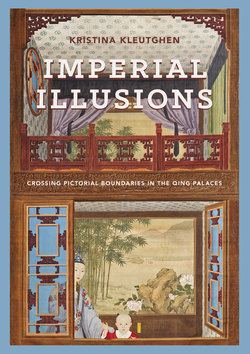Читать книгу Imperial Illusions - Kristina Kleutghen - Страница 90
На сайте Литреса книга снята с продажи.
Оглавлениеyou will glimpse the sky and see the stars. When your painting reaches this point, only then will you understand the Western methods. If you study this intensively, the results will be miraculous. How could this not delight the eye?”60 These two images and their accompanying comment synthesize all of Nian’s goals for the treatise: mastery of Western painting methods and the ability to deceive a viewer with such skillful works. However, the presence of this illustration in the center of the treatise diminishes its importance. If it had been placed at the end as a summation of all that could be achieved, it would have been a far more effective demonstration of what the treatise sought to teach.
To identify the overhead vanishing point in this sequence of ceiling paintings, Nian does not use his standard term “head point” or “main head point,” but rather “heavenly point” or “skyward point” (tiandian). In the Perspectiva, Andrea Pozzo’s use of perspective was inseparable from his religious devotion and evangelical mission as a Jesuit: he urged his readers to approach linear perspective “with a resolution to draw all the lines thereof to that true POINT, the Glory of GOD.”61 By identifying the vertical vanishing point as the “heavenly point,” Nian may inadvertently reveal something of the Christian ideology with which he may have been taught perspective, despite the fact that Kangxi had officially banned Christianity after the Chinese Rites controversy in 1721. Although Gaubil wrote in a letter that Nian kept Christian fasts, prayed Christian prayers, kept only one wife, and “should have been baptized if he had not been prevented by death,” there is no other indication that Nian was in any way a Christian, and Gaubil was the only one known to have made such a comment.62 All of Nian’s publications instead point entirely to the contrary: like the High Qing emperors, Nian was attracted not to Western religion, but to its objects and ideas, and includes no discussion of either Christianity or the Jesuits— not even identifying Giuseppe Castiglione as a Jesuit in the prefaces. Those with prior knowledge of Christianity might see a Christian metaphor in tiandian, but The Study of Vision otherwise shows no sign that Nian himself either did or wanted to, and at best it is ambiguous. In Chinese, tiandian is a logical term to use for these images with potential but not necessarily religious symbolism. Although tian can refer to the divine, such as in the Mandate of Heaven (tianming) that any emperor must strive to deserve and maintain, it also simply refers to the sky or the heavens. Unaccompanied by any discussion of divine symbolism, therefore, the “heavenly point” in these ceiling paintings merely indicates the highest point in a view that opens up toward the sky. The use of linear perspective in The Study of Vision therefore carries neither European nor Christian metaphors, regardless of the Jesuit origins of the subject in China. Despite the best efforts of the Jesuits and persistent scholarly attempts to link linear perspective in The Study of Vision with the connotations of Jesuit perspective, any deeper metaphorical significance for perspective or the vanishing point in The Study of Vision is uniquely Chinese.
It is entirely possible that Nian personally experienced the effects of such ceiling paintings, and that these images in the seventh section reflect not only the Perspectiva but also the appearance of now-lost paintings in Beijing’s Jesuit churches. Jean-Baptiste
